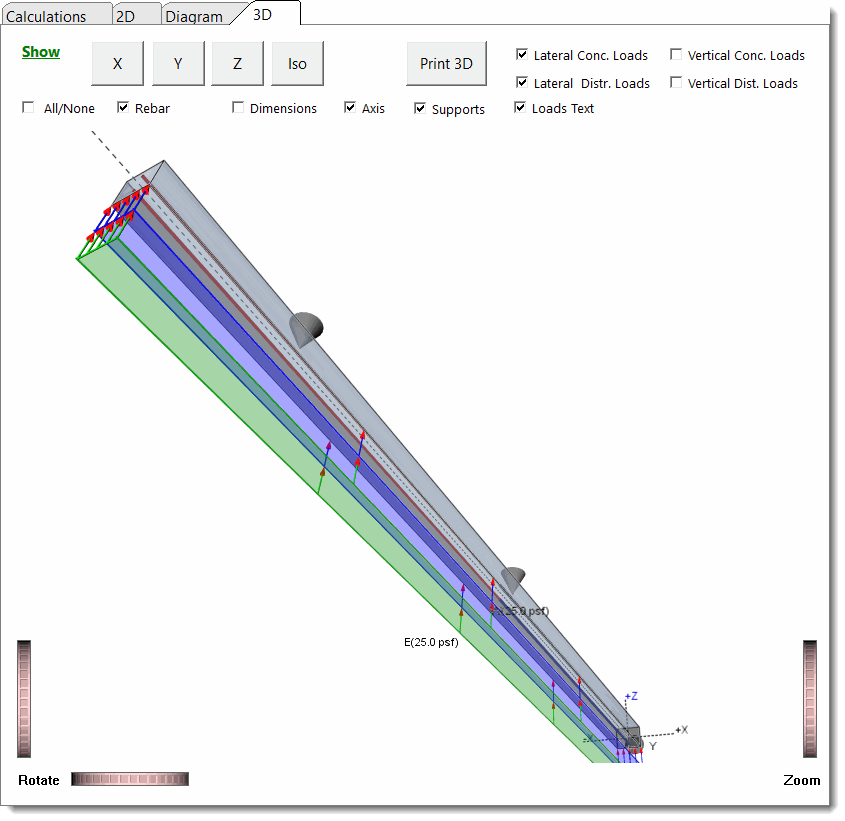This module provides design and analysis according to the new provisions for design of masonry walls, using the P-Delta deflection considerations now included in the IBC.

This method lifts the restriction on H/t ratios, and performs wall analysis using the principles of ultimate strength design. The design method is very similar to that of the Concrete Slender Wall module.
This module uses a variable width strip of wall section to represent a typical section of wall. The module has the ability to apply a lateral wind load, seismic load, partial length uniform lateral load, and a lateral point load to the clear span of the wall section. This variety of loadings should take care of almost every lateral loading case possible.
The user may specify masonry and reinforcing strengths, seismic factor, wind load, vertical and lateral loads, vertical load eccentricities, and wall construction. The module determines the wall capacity, actual deflections considering P-Delta effects, and solves for the final moments obtained through iteration of the P-Delta effects. Deflection analysis is provided for both service and factored load cases.
The user reaches a final design by modifying wall thickness, rebar size, and rebar spacing until no overstress condition exists and the deflection limits prescribed in the code are satisfied.
This module uses basic principles of structural mechanics to model the wall as a series of beam segments. For each segment the actual moment is used to calculate member stiffness using the Ieffective equations developed by Peter H. Bischoff. Since these changes to wall stiffness affect the wall deflection profile, the program performs an iterative analysis of calculating moments (including P-Delta effects). The results are deflection curves almost exactly matching the SCCACI-SEAOSC test results. This makes this module far more accurate at calculating wall deflections and P-Delta effects than the simple equations in the ACI code.
Capabilities
This module provides these capabilities:
•One or two story slender masonry walls
•Iterative process accounts for P-delta
•Optional parapet
•Axial loads with optional eccentricities
•Wind, seismic and user defined lateral loads creating bending on the wall panel
•Variable strip width to model the wall panel
•Temperature differential can be specified across thickness of wall to add curvature
General
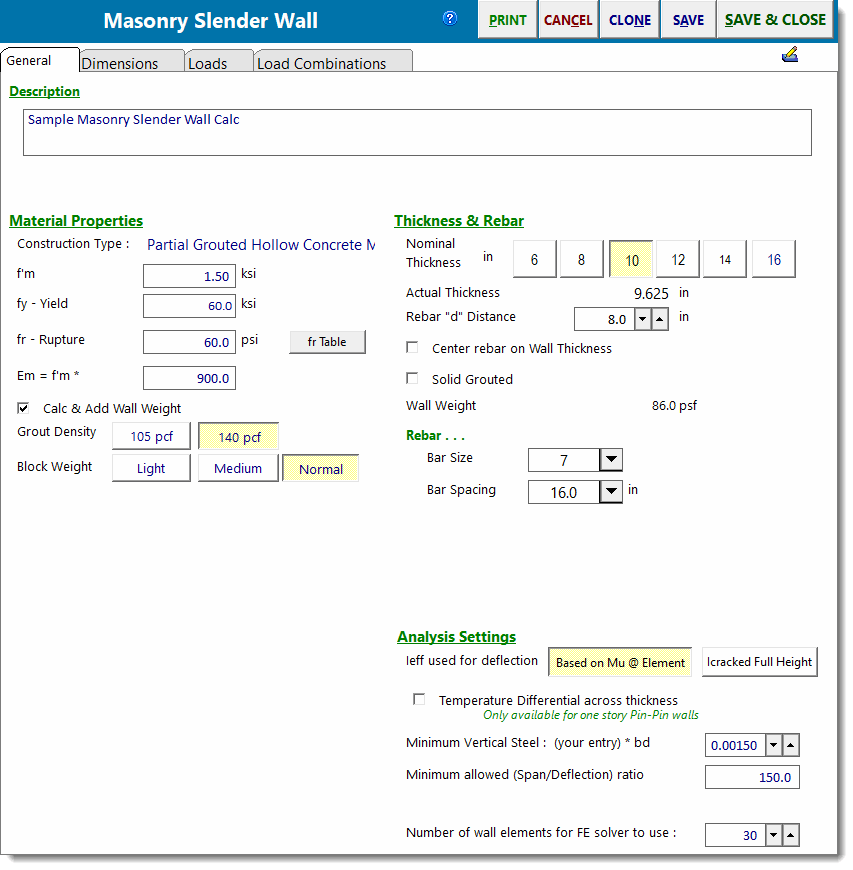
Material Properties
f'm
Enter the allowable masonry strength to be used in the analysis. The allowable bending and axial stresses calculated from f'm are outlined in a later section.
fy
Yield point stress of reinforcing.
fr - Rupture & fr-Table
Modulus of rupture for the masonry wall system.
Em = f'm * [value]
The modulus of elasticity of the masonry wall system is specified by this value acting as a multiplier to f'm.
Grout Density
Choose from two different options for the density of the grout.
Block Weight
Select light, medium and normal weight block. The weight of a completed wall is determined from the masonry database, depending on the block weight, grout density, and grouted cell spacing. To view the database values click Databases > Concrete Masonry Unit Data from the main menu. Here is what you will see:
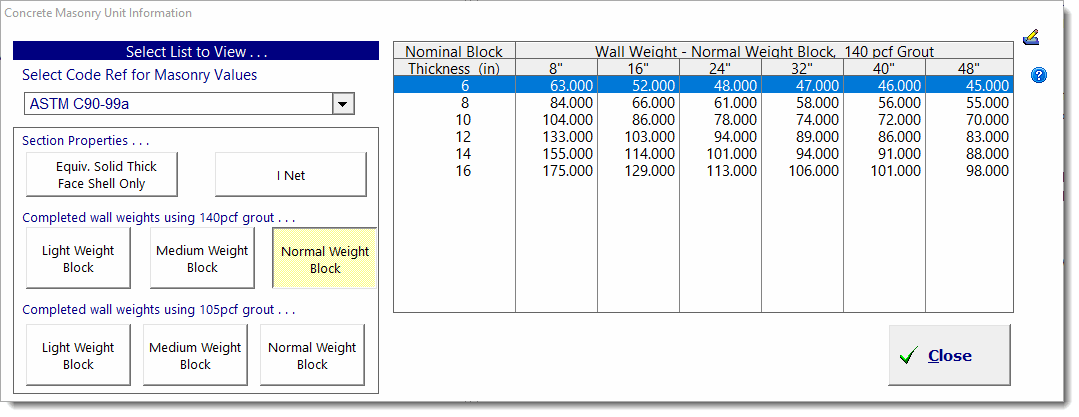
Thickness & Rebar
Nominal Thickness
Select the nominal thickness for the concrete masonry units used in the wall construction. This selection will pull the values for wall weight, equivalent solid thickness and Igross from the masonry database (see above).
Actual Thickness
The actual wall thickness for the nominal selection.
Rebar "d" Distance
Enter the distance from the extreme compression fiber to the center of the rebar.
Solid Grouted
Select this checkbox if the wall is to be grouted solid . If unchecked the module will calculate the wall weight considering that grouted cells only occur at the spacing of the reinforcing.
Wall Weight
Weight of wall as retrieved from the masonry database. Value is based on specified wall thickness, grout density, block type, and grouting frequency.
Rebar Size & Spacing
Enter the rebar size and spacing.
Analysis Settings
Ieff used for deflection
The module always performs an iterative analysis for moments and deflections using progressively greater wall deflections due to increasing P-Delta effects.
Temperature Differential across thickness
This input is used to describe the temperature change between each face of the wall. A temperature change induces a slight curvature into the wall because the hotter side expands, resulting in a slightly higher out-of-plane deflection.
Enter temperature differentials as positive values. The effects of a specified temperature differential are always additive with the bending and deflection resulting from other applied loads.
Minimum Vertical Steel: %/100
Minimum steel percentage as a portion of the gross wall area.
Minimum Allowed (Span/Deflection) Ratio
This setting establishes the minimum allowable ratio of span length to service load deflection. If a lower actual Span/Deflection ratio occurs (meaning greater deflection), a warning message will be displayed.
Number of wall elements for FE solver to use
This module divides the wall design strip into segments from the base to the top for analysis purposes. Use this entry to define the number of segments to use. Experience demonstrates that approximately 30-40 segments gives a good balance between the iterative P-Delta analysis reaching convergence and excessive calculation time.
Dimensions
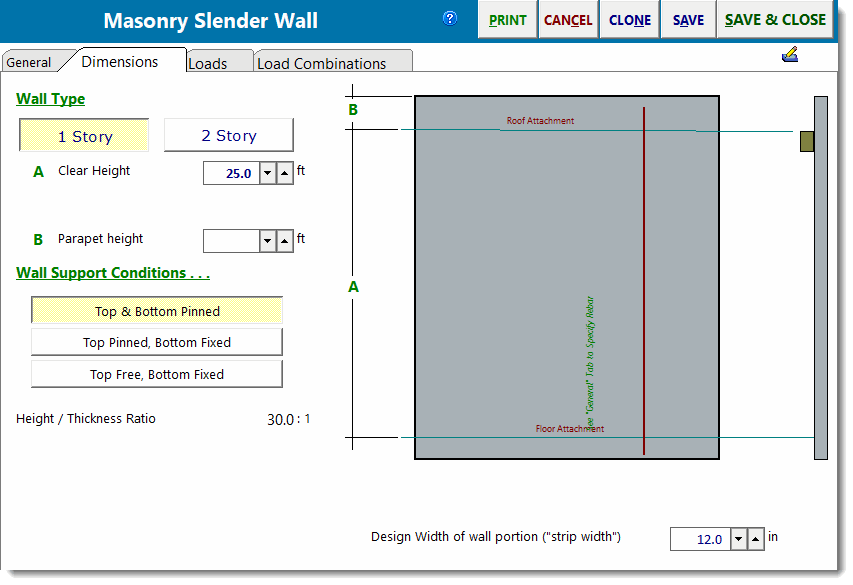
Clear Height
Span of the wall between the base and the first lateral support. For one story walls this is the top support. For 2 story walls this is this prompt will change to be "1st story height".
Parapet Height
Distance the wall extends above the topmost lateral support (clear height for one story wall, 2nd story height for 2 story walls)
Wall Support Conditions
Controls how the top and bottom of the wall are restrained for moments and lateral movement.
[Top & Bottom Pinned]
Base of wall is restrained against movement out of plane and vertically, rotates freely. Top of wall restrained against out of plane movement and can move vertically and rotate freely.
[Top Pinned, Bottom Fixed]
Base of wall is restrained against movement about all three axes. Top of wall restrained against out of plane movement and can move vertically and rotate freely.
[Top Free, Bottom Fixed]
Base of wall is restrained against movement about all three axes. Top of wall is completely free making this a cantilevered wall.
Design Width of wall portion ("strip width")
This module performs its analysis for this width. Results are for either for this width or a 12" width as noted where the results are provided.
Note that applied loads either are applied to the entire strip width (as for concentrated vertical and lateral loads) or are entered on a per-foot basis when they are uniform loads.
Two Story...
When a two story wall is selected this tab changes slightly to provide the 2nd story height and remove the Fixed-Free support option.
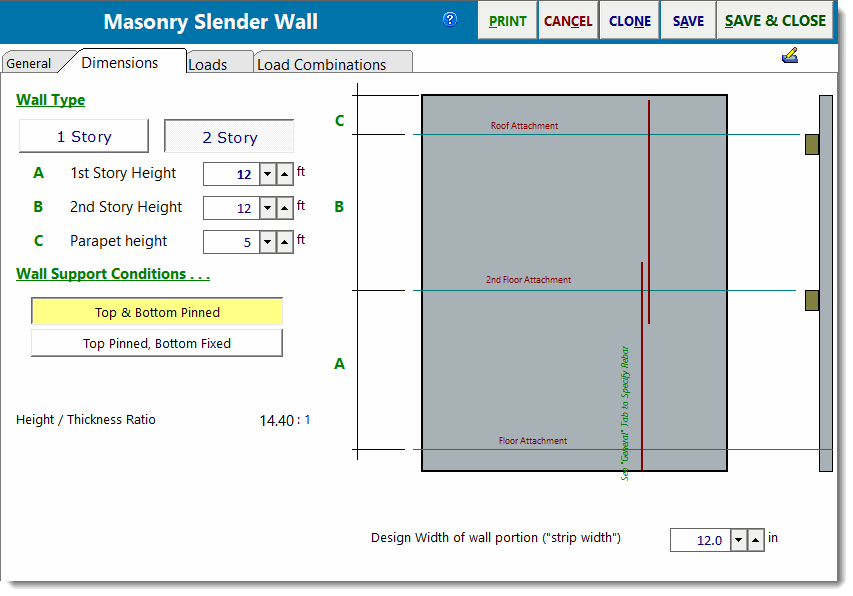
1st Story Height
Distance from the bottom of the wall to the first lateral support.
2nd Story Height
Distance from the first lateral support to the top lateral support.
Loads - Vertical
A variety of vertical loads are available. Note the hint describing whether the load is per foot or on the entire strip width.
All loads that are entered on this tab will be multiplied by the load factors specified on the Load Combination sub-tabs. So these magnitudes should be specified with those load factors in mind.

Ledger Load
This is a per-foot vertical load applied to the wall at an optional eccentricity. So if you have a 48" strip width and specify a 1 k/ft dead load then the strip will have a total of 4 kip applied due to the 1 k/ft entry.
Concentric Load
This is a per-foot vertical load applied concentrically to the wall. So if you have a 48" strip width and specify a 1 k/ft dead load then the strip will have a total of 4 kip applied due to the 1 k/ft entry.
Mid-Height Vertical Uniform Load
This load entry is only shown for 2-story walls. It allows you to specify two uniform loads applied at the "1st Story" height, one of which can have an eccentricity from the wall center.
Concentrated Loads
These are single concentrated vertical loads applied to the wall "strip width" with an optional eccentricity.
Distance from Base is the height at which the load is applied.
| Eccentricity describes an offset from the mid-thickness of the wall panel, which is the default location of application of a vertical load. Enter this value as a positive number when the load is shifted toward the inside of the wall. |
Loads - Lateral
Lateral loads are applied perpendicular to the plane of the wall and are almost always seismic or wind. These loads create out-of-plane deflection of the wall, which the module will use to develop P-Delta effects to calculate secondary moments in the wall. Recall from other explanations that the module divides the wall into small segments and calculates the allowable and actual forces and deflections for each small segment. In this way the lateral loads are properly modeled on what is a beam with variable stiffness due to the state of cracking in each segment.
All loads that are entered on this tab will be multiplied by the load factors specified on the Load Combination sub-tabs. So these magnitudes should be specified with those load factors in mind. All lateral loads must be entered as positive values.
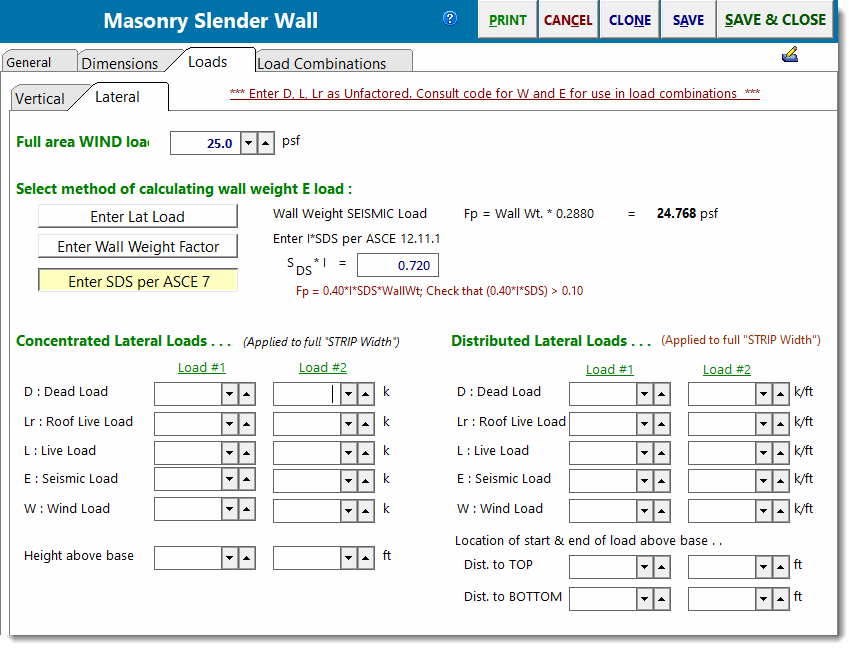
Full area WIND Load
Enter the wind load that will be applied to the wall in the out-of-plane direction. This load will only be applied to one surface of the wall, and as such, the magnitude must take into consideration both the internal and external pressures.
Wall weight seismic load
This section offers three options to specify the seismic load that will be internally applied to the wall in the out-of-plane direction:
Enter Lateral Load: This entry is a simple net load applied to the wall (but will still be factored by the load combination factors for "E").

Enter Wall Weight Factor: Enter a number that will be multiplied by the self-weight of the wall. For example, if you enter 0.25 and the wall weighs 80 psf, then a 20.00 psf out-of-plane load will be calculated and applied to the wall using the load combination factors for "E".

Enter SDS per ASCE 7: Enter the (SDS * I) value as prescribed by the ASCE code for the building location. The minimum calculated load value of 10 psf or (0.4 * Value Entered * Wall Weight) will be applied to the wall using the load combination factors for "E".

Fp
This is the actual seismic load applied perpendicular to the plane of the wall, which represents the wall's seismic self weight load.
Concentrated Lateral Loads
This is an added lateral load applied perpendicular to the plane of the wall. It acts on the full "Strip Width" and is factored by the load combination factors corresponding to the type of load.
Distributed Lateral Loads
This is an added lateral uniform load applied perpendicular to the plane of the wall. It acts on the full "Strip Width" and is factored by the load combination factors corresponding to the type of load.
You also enter the start and end distance of the load extent above the base of the wall.
Load Combinations
Typical load combination information as used throughout ENERCALC SEL.
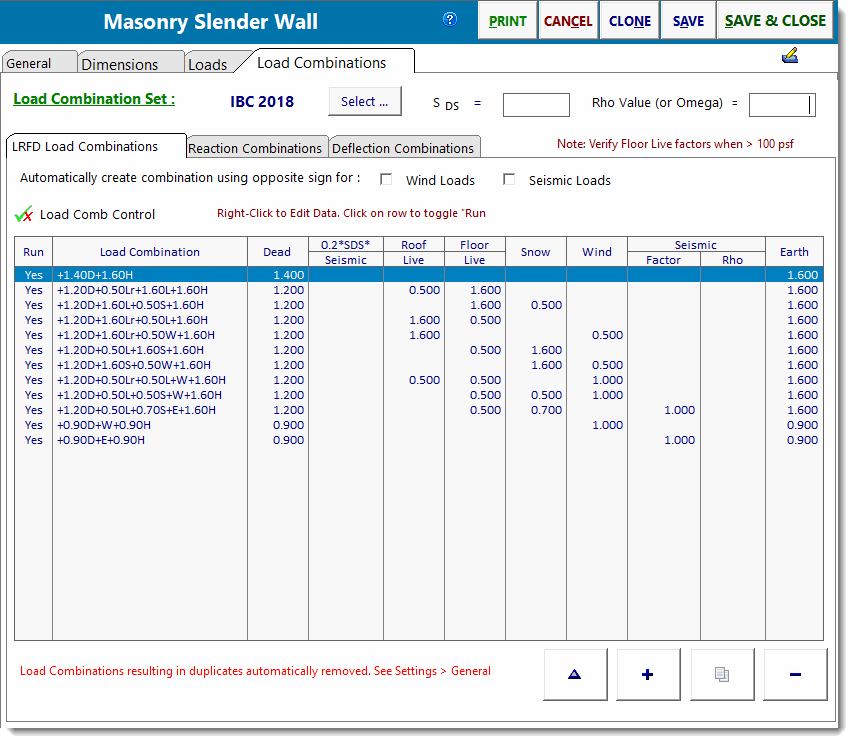
Summary
This tab presents the critical results as calculated by the module.
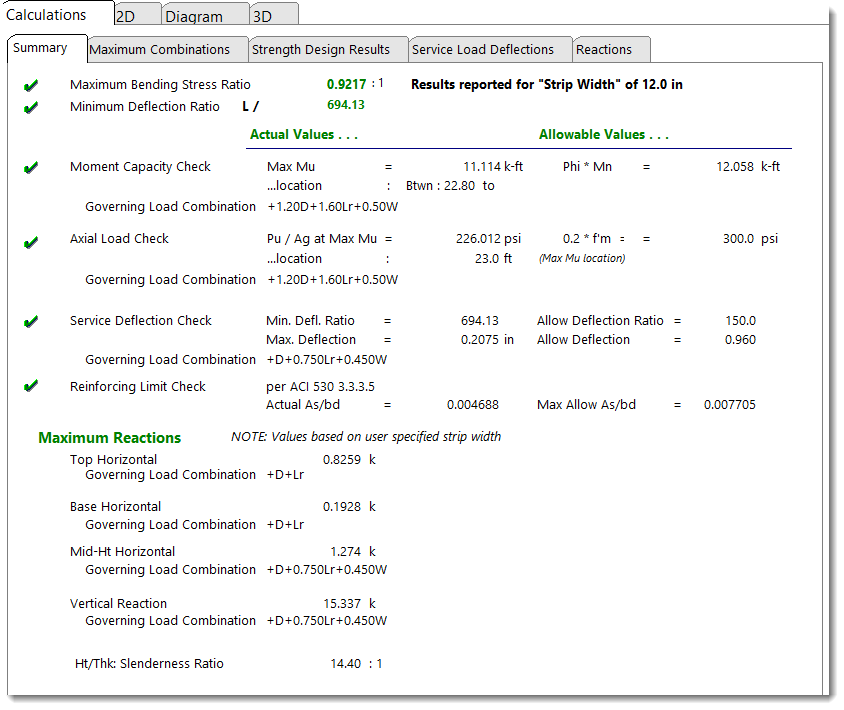
Maximum Bending Stress Ratio
The module looks at the detailed results for ALL strength design load combinations at all "segments" in the wall and pulls out the maximum factored load bending stress ratio to present here as the governing condition.
Minimum Deflection Ratio
The module looks at the detailed results for ALL service load combinations at all "segments" in the wall and pulls out the minimum service load deflection ratio (meaning maximum deflection) to present here as the governing condition.
Moment Capacity Check
For the condition of maximum bending stress ratio, the actual applied and allowable bending moments are given along with the governing load combination.
Axial Load Check
The module checks the factored axial stress in all segments for all load combinations and gives the maximum actual stress Pu/Ag. The allowable value is the result of the wall slenderness. If the slenderness is less than or equal to 30, the allowable value of factored axial stress is 0.20f'm. If the slenderness is greater than 30, the allowable value of factored axial stress is 0.05f'm.
Service Deflection Check
For the condition of minimum deflection ratio (meaning maximum deflection) the ratio, deflection, allowable minimum ratio, allowable deflection (based on allowable ratio) and governing load combination are reported.
Reinforcing Limit Check
The module checks all portions of the wall for reinforcing (including differently reinforced first and second stories) and reports the maximum reinforcing ratio and compares it with the maximum percentage of balanced section analysis As allowed.
Minimum Moment Check
ACI specifies that a wall section in bending shall have a minimum strength Mn that is greater than the cracking strength Mcr = Sgross * fr.
Maximum Reactions
This gives a summary of the maximum reactions (both out-of-plane and vertical) along with the load combination that creates them.
Maximum Combinations
This tab provides a summary of the governing values for each load combination for both factored load axial & bending and service load deflections.
Factored Load Maximum Moments for Load Combinations: The module looks through the result set for each load combination and identifies the location above the base of the wall at which the maximum condition is found. Note that "Aseff" is the effective area of steel and is influenced by the axial compression in that segment.
Service Load Maximum Deflections for Load Combinations: The module looks through the result set for each load combination and identifies the location above the base of the wall at which the maximum out-of-plane deflection is found. The value for "Ieff" is specific to the segment at that location and is based on the actual moment and Bischoff's equation for calculating effective moment of inertia.

Strength Design Results
This tab provides an extremely detailed summary of the factored axial load, moments, effective steel area and moment of inertia at each wall analysis segment for each load combination.
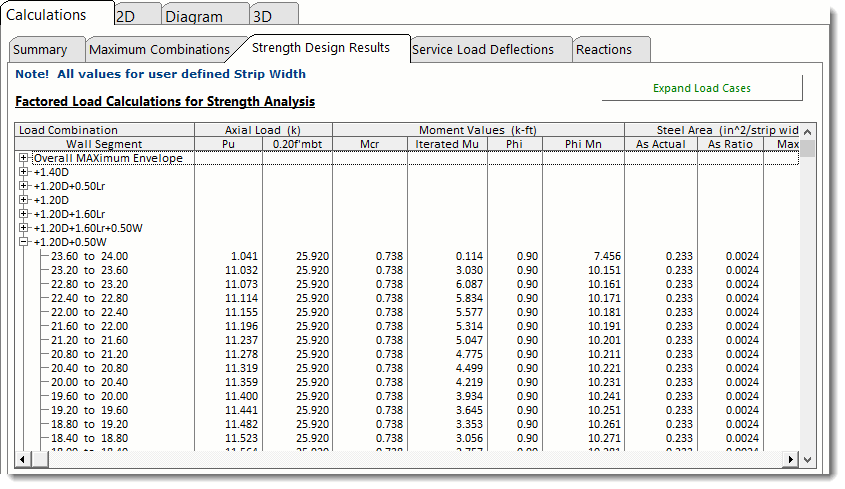
Service Load Deflections
This tab provides an extremely detailed summary of the service axial load, moments, effective moment of inertia and calculated deflection at each wall analysis segment for each load combination.
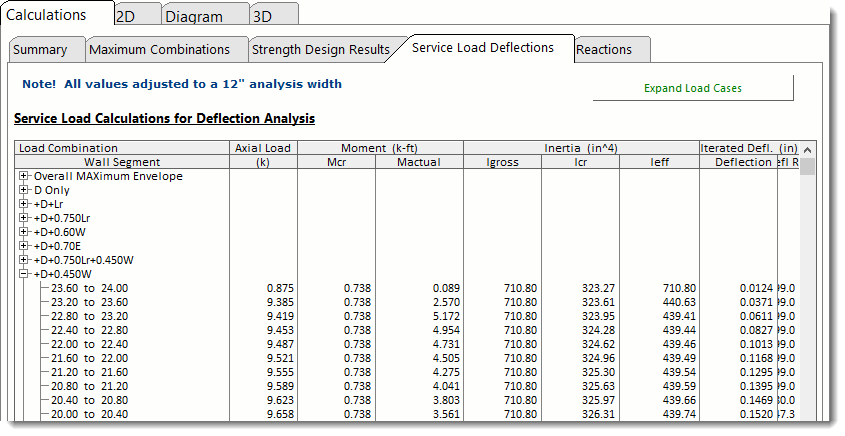
Reactions
This tab gives a summary of out-of-plane and vertical base reactions for each service load combination.

2D Sketch
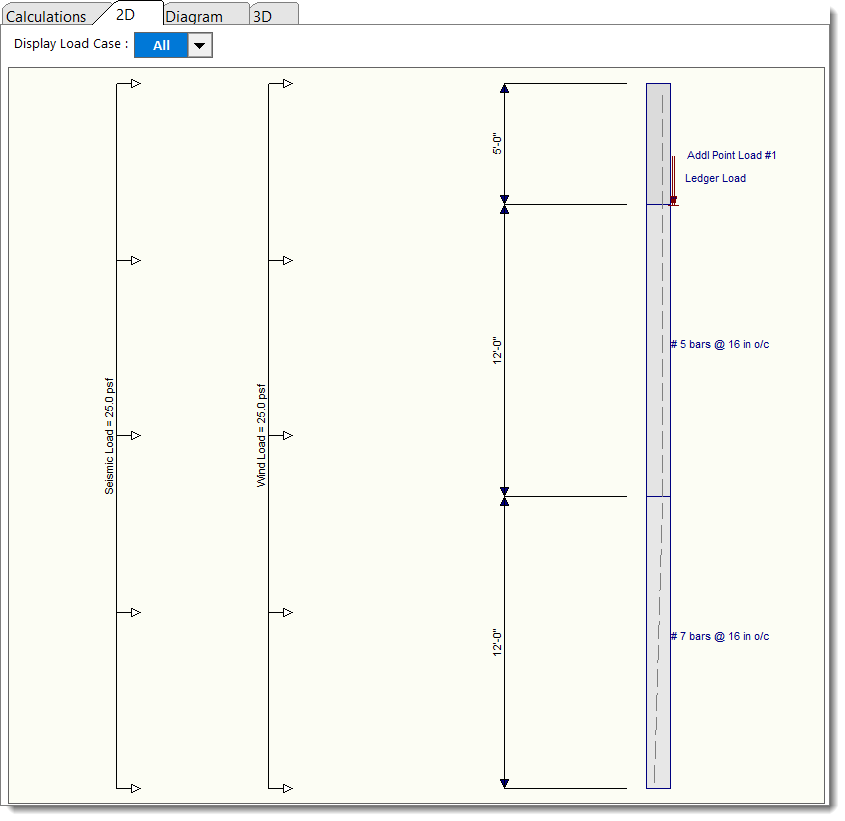
Diagram

3D Rendering
